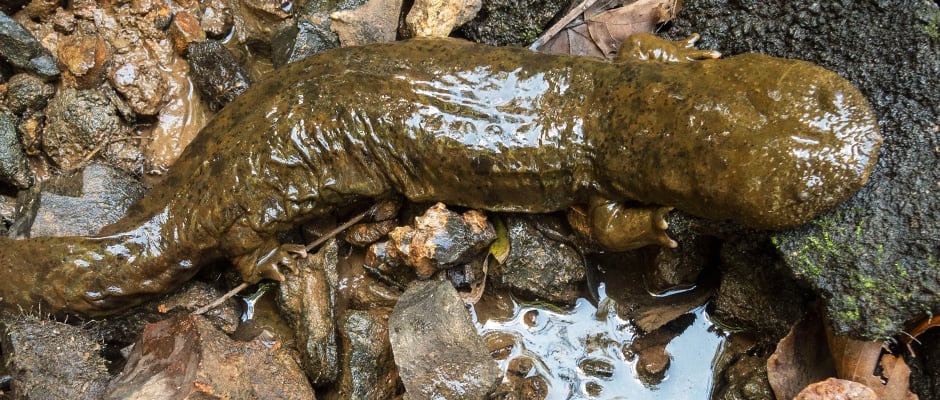Share this article
Hot on the Alabama Trail of the Elusive Hellbender
It was midafternoon on the last day of the search, and nothing had turned up. Thomas Floyd had been invited to Alabama a few weeks ago to help track down the eastern hellbender (Cryptobranchus alleganiensis) — a species of salamander thought to be extirpated from the state. The last of the salamanders to turn up in formal surveys had been discovered in 1979, but a few unconfirmed sightings had been reported in recent years and a video surfaced in March last year of a hellbender pulled out of in Cypress Creek in northern Alabama.
“Every few years an observation would pop up, or an anecdotal report,” said James Godwin, a researcher in the University Museum of Natural History at Auburn University, Ala. “That stimulated interest in studying the hellbender in Alabama,” he said, adding that the state is at the southern terminus of the amphibian’s range.
Godwin received funding for a formal survey from Alabama Department of Conservation and Natural Resources to investigate the status of the salamander. “Our approach is a combination of old-style field work and modern lab work,” he said. “In the field we lift rocks in an attempt to find an actual salamander. “ Lesley de Souza directed the collection of water samples to be analyzed in the lab for hellbender DNA, he said.
But he was a week into the survey, and the team hadn’t found anything yet.
“It’s a frustrating thing to survey for a rare species and not find one,” Floyd said. It was the right time of year, mid-September when the salamanders were a little more active due to it being breeding season. The water levels of the creeks and streams were also relatively low, but they hadn’t spotted anything and the DNA samples would take a while to process for potential hellbender presence.
But luckily they’d called in Floyd, the wildlife biologist with the Georgia Department of Natural Resources who has a good track record of catching hell(benders) nearly everywhere he goes.
Hours before he was heading back to Georgia, Floyd and the other researchers’ luck changed. They were about to turn in, but noticed a suitable rock and habitat and set up a final canoe float on a bend of the Flint River, just east of Huntsville near the Tennessee border.
“I found a rock, lifted it and there it was,” Floyd said. “I nabbed it.”
Godwin was in another section of the waterway when the discovery was made, but it was easy to tell what had occurred immediately. “There was plenty of yelling going on when they’d found it,” Godwin said, adding that the roughly half-dozen researchers were “ecstatic” to have found a live specimen.
“Some of the common names are snot otter and lasagna lizard,” Godwin said. “It’s just an incredible animal.”
They took measurements, determined the hellbender to be female, and implanted it with a PIT tag, a small rice-sized piece of copper that researchers can detect with a special tool they wave over the animal if they catch it again.
What Does It Mean?
But while the discovery is wonderful as it confirms some hellbender presence, all that glitters may not be gold.
“To stop and think that they’re out there in such low numbers, the question is whether we have any viable populations,” Godwin said. “In the early stages, we’re just trying to figure out where we are on this.”
The researchers are still waiting on the DNA data from the water, however, they determined the female hellbender was an older amphibian, and they didn’t find any eggs nearby. Hellbenders can live up to at least 29 years, meaning it could have been isolated in Flint River for a long time without a chance to breed.
“If you are only able to find a few old individuals, the population is not very healthy,” Floyd said.
Floyd has been running surveys back in Georgia since 2011, returning to the same locations every three years. In 2012, he had 94 captures, and when resurveying those same areas this year, he had six recaptures apart from a number of new captures — good news, in Floyd’s view.
“If I were catching the same individual it would indicate a small population,” he said, though he cautions that researchers are still in the process of establishing baseline population numbers there. They also took water samples to test for hellbender DNA and found evidence of hellbenders nearly everywhere they expected to find them.
“Fortunately a lot of the Georgia streams are in good shape,” Floyd said. “The populations are in good shape.”
Sweet Home Alabama
Back in Alabama, the jury is still out on whether there is a viable population of hellbenders.
“The next question is, if we do not, what can we do?” Godwin said. More work on establishing a baseline population could result in a listing under the Endangered Species Act if numbers are small enough. And if it turns out hellbenders have mostly been extirpated, with a few old and isolated individuals hanging on, Godwin said the state may think about reintroduction plans.
“I’ve been doing this for a long time so I’m kind of hesitant to be too excited about it,” he said. But while the Alabama team is looking into the DNA samples, more good news recently came of Floyd from Mississippi —just last week he caught a hellbender there, the first confirmed since the last formal survey in 1996.
Header Image: One of the first female hellbenders confirmed in a formal survey in Alabama in decades.
Image Credit: James C. Godwin









